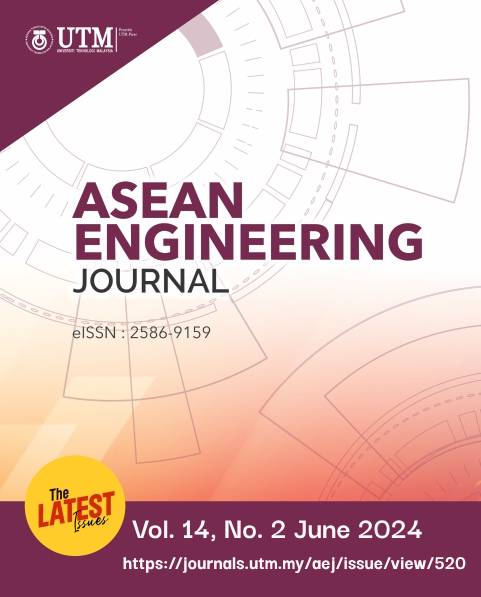PRESSURE DROP IN VERTICAL TURBULENT BUBBLY FLOWS: A THEORETICAL MODELLING APPROACH
DOI:
https://doi.org/10.11113/aej.v14.20701Keywords:
Pressure drop, bubbly flow, adiabatic, eddy diffusivities, air-water systemsAbstract
A method based on the concept of eddy viscosities due to turbulence and bubble agitation is utilized along with appropriate correlations available in the literature in order to estimate the total pressure drop in a vertical bubbly flow. The method aims to minimize the experimental measurements required to calculate the pressure drop which remains the most significant quantity of engineering interest in fluid flows. It has been shown in this work through experimental comparisons that these correlations can make the procedure independent from the knowledge of experimental measurements and yet are able to estimate the total pressure drop with good accuracy.
References
Hwang, J., Yoo, Y.-C., Park, S.-Y., and Choi, D. 2022. Analytical Study of Unsteady Boiling Characteristics of Steam Generator. Technology and Economics of Smart Grids and Sustainable Energy. 7(1): 13.
Chen, J. and Brooks, C. S. 2021. Experiments and CFD simulation of mass transfer and hydrodynamics in a cylindrical bubble column. Chemical Engineering Science. 234: 116435.
Sivasankaran, S. and Mallawi, F. O. 2021. Numerical study on convective flow boiling of nanoliquid inside a pipe filling with aluminum metal foam by two-phase model. Case Studies in Thermal Engineering. 26(101095.
Mulbah, C., Kang, C., Mao, N., Zhang, W., Shaikh, A. R., and Teng, S. 2022. A review of VOF methods for simulating bubble dynamics. Progress in Nuclear Energy. 154: 104478.
Sato, Y., Sadatomi, M., and Sekoguchi, K. 1981. Momentum and heat transfer in two-phase bubble flow—I. Theory. International Journal of Multiphase Flow. 7(2): 167-177.
Haoues, L., Olekhnovitch, A., and Teyssedou, A. 2008. Influence of the void fraction profile on the distribution parameter C0 for a bubbly gas–liquid flow in a horizontal round pipe. Nuclear engineering and design. 238(4): 1155-1158.
Riviere, N. and Cartellier, A. 1999. Wall shear stress and void fraction in Poiseuille bubbly flows: Part I: simple analytic predictions. European Journal of Mechanics-B/Fluids. 18(5): 823-846.
Sato, Y. and Sekoguchi, K. 1975. Liquid velocity distribution in two-phase bubble flow. International Journal of Multiphase Flow. 2(1): 79-95.
Sekoguch, K., Nakazatomi, M., Sato, Y., and Tanaka, O. 1980. Forced convective heat transfer in vertical air-water bubble flow. Bulletin of JSME. 23(184): 1625-1631.
Rouhani, S. Z. and Axelsson, E. 1970. Calculation of void volume fraction in the subcooled and quality boiling regions. International Journal of Heat and Mass Transfer. 13(2): 383-393.
Rodrigue, D. 2004. A general correlation for the rise velocity of single gas bubbles. The Canadian Journal of Chemical Engineering. 82(2): 382-386.
Maeda, N. 1975. Behavior of a single bubble in quiescent and flowing liquid inside a cylindrical tube. Journal of Nuclear Science and Technology. 12(10): 606-617.
Friedel, L. 1979. Improved friction pressure drop correlations for horizontal and vertical two-phase pipe flow. European two-phase group meeting, Ispra, Italy,
Thome, J. R. 2004. Engineering data book III. Wolverine Tube Inc. 2010
Choi, K., Muhammad, N., Rehmani, M., and Kim, D. 2012. Hybrid piezo-electrostatic inkjet head for printed electronics. Proceedings of the Institution of Mechanical Engineers, Part C: Journal of Mechanical Engineering Science. 226(3): 842-857.
Esa, Z., Zaini, J. H., Mehdi, M., Iqbal, A., and Nauman, M. M. 2023. Design, Fabrication & Analysis of a Gravitational Water Vortex Based Energy Harvester. International Journal of Green Energy. 20(1): 77-88.
Muhammad, N. M. 2017. Adaptive boundary input heat flux and temperature estimation in a three-dimensional domain. Heat Transfer Research. 48(3): 239-261
Muhammad, N. M., Kim, K.-Y., Huang, C.-H., and Kim, S. 2010. Groundwater contaminant boundary input flux estimation in a two-dimensional aquifer. Journal of Industrial and Engineering Chemistry. 16(1): 106-114.
Nauman, M. M., Sameer, M., Mehdi, M., Iqbal, A., and Esa, Z. 2020. Heat Transfer and Pressure Drop in Wavy-Walled Tubes: A Parameter-BASED CFD Study. Fluids. 5(4): 202.
Choi, K.H., Muhammad, N. M., Rehmani, A.A.A, and Kim, D. S. 2012. Hybrid piezo-electrostatic inkjet head for printed electronics. Proceedings of the Institution of Mechanical Engineers, Part C: Journal of Mechanical Engineering Science. 226(3): 842-857.
















